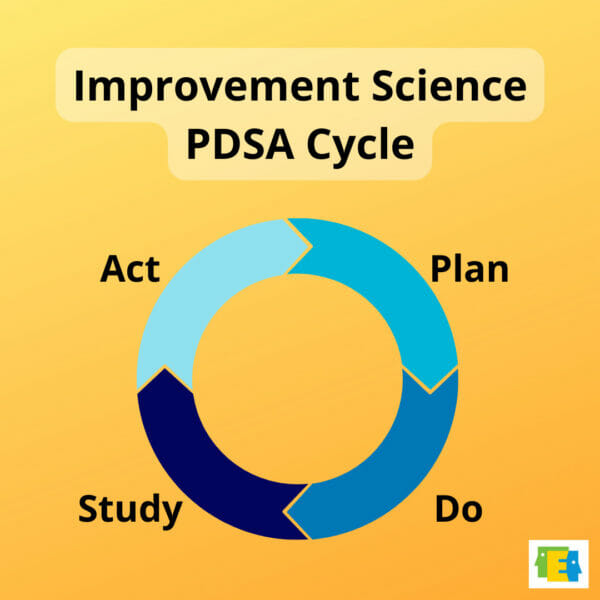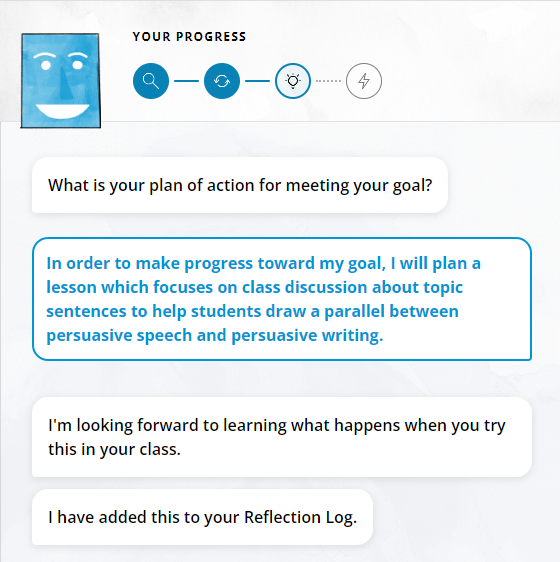Build An Effective School Improvement Plan By Ensuring Teachers Can Monitor Progress

A good school improvement plan helps align district and school priorities, clarifies what teachers are driving toward, and sets clear ways to measure goals at the end of the year.
But what does this look like on a day-to-day basis?
Teachers can choose instructional techniques to try based on an outlined vision and big goals, but they need data to know if those tactics are actually working.
An effective school improvement plan includes both year-end metrics as well as a process for all teachers to monitor progress and experiment with classroom strategies to understand their ongoing impact in a repeatable way.
Enter Improvement Science and the Plan-Study-Do-Act Cycle, a framework that provides structure for educator and schoolwide growth.
This blog post explains the best practices of the research-based approach of Improvement Science and why you should build this into your school improvement plan.
We’ll also talk about how integrating the ideas of the PDSA Cycle into your school improvement plan can support teachers and increase the whole building’s clarity as part of the ongoing progress monitoring.
Improvement science provides structured cycles for teachers trying out classroom strategies
Improvement Science is a framework studied and recommended by the Carnegie Foundation for the Advancement of Teaching that provides a data-driven process for continuous teacher improvement.
The approach is rooted in data, inquiry, and iteration; Improvement Science prioritizes the idea that a teacher is constantly experimenting within their classroom. 
A key feature for structuring teacher inquiry and iterating quickly is the PDSA Cycle. PDSA stands for Plan-Do-Study-Act.
In a nutshell, PDSA guides teachers to:
- Plan. Make a prediction about a change they will try in their teaching
- Do. Try that change
- Study. Collect classroom data resulting from that change
- Act. Determine the next steps for their teaching
School improvement plans often contain school-wide, long-term goals, but classroom teachers must be able to measure their impact on a daily and weekly basis. The PDSA Cycle is a tool kit that can help teachers collect this data in an ongoing way.
Use Plan-Do-Study-Act Cycles in your school improvement plan to help teachers monitor progress
A school improvement plan may contain a variety of goals, from classroom-level pedagogy to curriculum choices to professional learning priorities to student attendance goals.
Improvement Science and the Plan-Do-Study-Act Cycle focus teachers’ efforts on running small experiments related to making progress against the bigger-picture goals.
The opportunity for someone writing a school improvement plan is to explicitly include the use of PDSA Cycles. This provides teachers with a structure throughout the year to monitor progress so that the plan is more likely to be effective. Putting PDSA Cycles into your school improvement plan also names this particular behavior as important and something that everyone should be doing.
Incorporating the PDSA Cycle steps into a school improvement plan also ensures that administrators are not leaving the process of ongoing monitoring to chance. Teachers and school leaders will have a toolset for gathering clear interim signals about progress toward classroom- and non-classroom-level goals.
For example, perhaps one goal in a school improvement plan is focused on the use of academic language in content areas to drive higher literacy overall. The end-of-year goal could be measuring an overall proficiency increase on the end-of-year standardized test.
But how can teachers know if the strategies they’re choosing throughout the year to try to improve students’ use of academic language are having a measurable near-term impact?
Plan-Do-Study-Act Cycles built into a school improvement plan can provide teachers with a structure for experimenting with classroom techniques and gathering data about their impact more frequently.
Having the PDSA Cycle and a framework for talking about ongoing progress avoids teachers feeling like the only thing being measured is the end-of-year impact. A mindset (and habit) of constant experimentation empowers teachers to constantly assess their impact and change course in ways that directly affect their particular set of students.
This means more efficient improvement with measurable student impact.
The key to gaining this efficiency and impact is your plan for implementation.
School leaders and administrators must be deliberate about giving teachers a system for implementing best practices of improvement science through PDSA Cycles.
Helping teachers create the routines for a PDSA Cycle requires support as well as an intentional effort to ask about how it’s going. To borrow from the quote often attributed to Peter Drucker, you can’t improve what you don’t support.
Administrators will need to provide teachers a structure for implementing Plan-Do-Study-Act routines into their daily work, as well as a plan to ask teachers about their learning and development throughout the school year.
All this comes with another benefit to administrators: Their building will be more likely to meet goals outlined in a school improvement plan because, as teachers collect data along the way, leaders can more proactively support their teachers to adjust course.
How the AI Coach platform can help teachers build Plan-Study-Do-Act habits
Building a school improvement plan with Plan-Study-Do-Act Cycles can support teachers to assess instructional strategies more iteratively toward big goal areas.
But helping teachers create the actual routines for PDSA Cycles takes time for an administrator: training teachers about the inquiry- and iterative-based process, ongoing data collection and monitoring, and sharing progress points.
AI Coach by Edthena is a platform that trains teachers to implement cycles of inquiry based on improvement science and the PDSA Cycle model. No extra work required from admins!
Teachers are guided on how to design and implement inquiry cycles and are supported to gather data along the way, and administrators have an easy way to check in on how teachers across a building are learning.
In the AI Coach platform, teachers work with a computerized coach through self-reflection, action-planning, and data collection as they try strategies meant to make progress toward classroom-level goals aligned to a school improvement plan goal.
First teachers upload a classroom teaching video to analyze and reflect on their teaching to, in the words of Jim Knight, get a clear picture of their current reality.
Then, teachers:
- Plan. Collaborate with the virtual coach to identify a classroom strategy they want to try
- Do. Implement the change within their classrooms and gather new data
- Study. Assess the impact of their change on student outcomes
- Act. Share back to the virtual coach if they will continue or try another strategy
Teachers are guided through the PDSA Cycle structure, without a need for additional training or additional processes managed by the administrators or instructional coaches in the building.
The AI Coach platform also provides teachers reminders about classroom data collection and gives them a clear place to record and synthesize data gathered from their PDSA Cycles.
For instructional coaches and school leaders, there’s a dashboard to understand teachers’ progress with completing cycles of inquiry as well as insight into the types of goals teachers are setting in order to support ongoing conversations about school improvement.
These are the best practices of improvement science in action, implemented without any extra effort for admin or teachers.
Try building PDSA Cycles into your school improvement plan
School improvement plans are an important way for all school stakeholders to understand the big goals and priorities to focus on.
Improvement science and the PDSA Cycle are research-based and, when built into a plan, ensure teachers can monitor progress of their instructional strategies in an ongoing way.
Making sure there is a structure in place for supporting Plan-Do-Study-Act cycles of inquiry will be key to supporting teachers to engage in meaningful learning and development and meeting school improvement plan goals.




